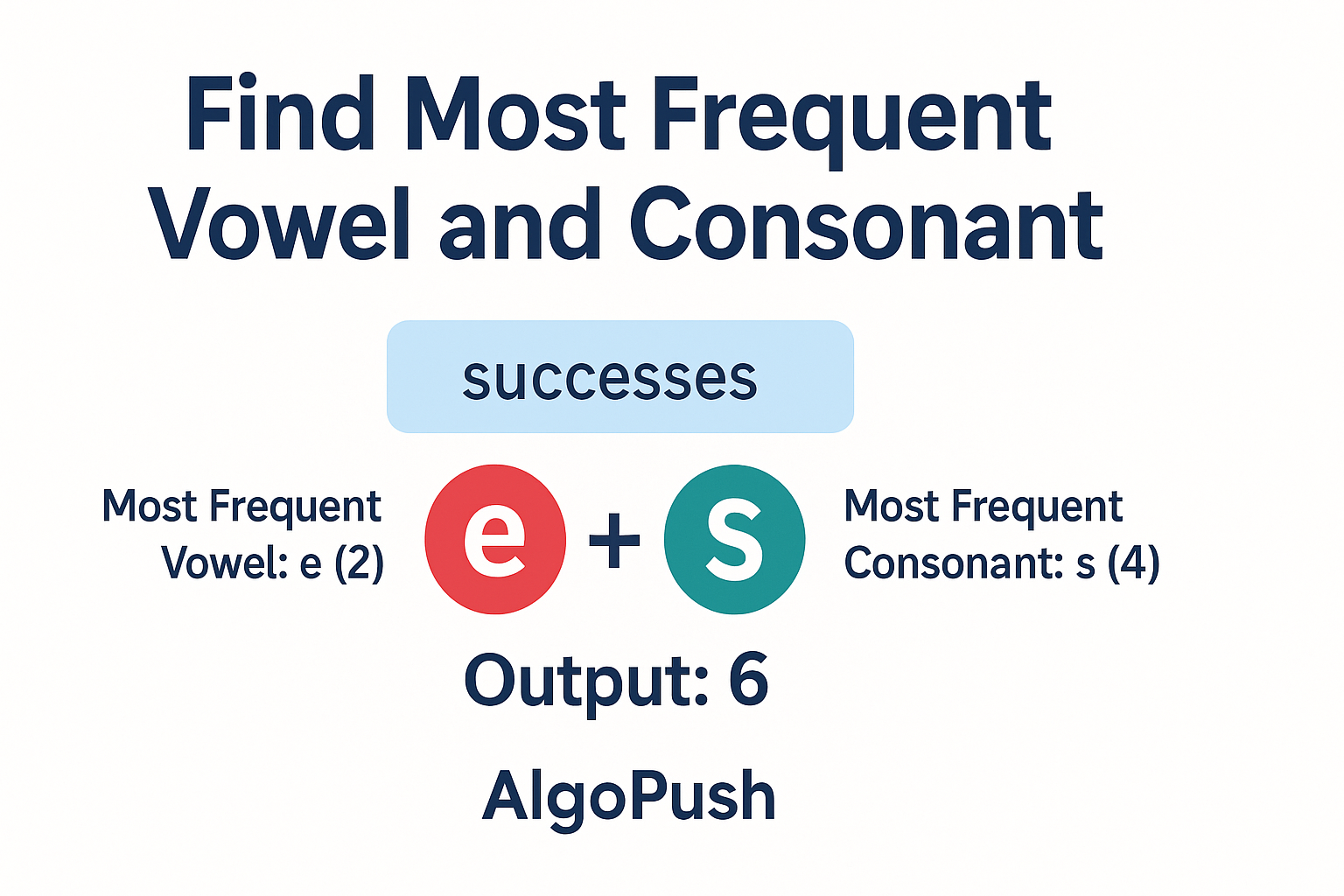
3541: Find Most Frequent Vowel and Consonant
Problem Statement
Given a string, return the sum of maximum vowel frequency and maximum consonant frequency. Handle edge cases where no vowels/consonants exist.
Example 1
Input: s = "successes"
Output: 6
Explanation: Max vowel (e) = 2, Max consonant (s) = 4Example 2
Input: s = "aeiaeia"
Output: 3
Explanation: Max vowel (a) = 3, No consonantsApproach 1: Frequency Array (Optimal)
Use fixed-size array to store character frequencies for O(1) lookups.
Algorithm Steps
- Initialize 26-element frequency array
- Count character occurrences
- Iterate through alphabet to find max frequencies
Complexity Analysis
| Time Complexity | Space Complexity |
|---|---|
| O(n) | O(1) |
class Solution {
public:
int maxFreqSum(string s) {
vector<int> freq(26, 0);
for(char c : s) freq[c-'a']++;
int max_vowel = 0, max_cons = 0;
for(int i = 0; i < 26; ++i) {
char c = 'a' + i;
if(c == 'a' || c == 'e' || c == 'i' || c == 'o' || c == 'u') {
max_vowel = max(max_vowel, freq[i]);
} else {
max_cons = max(max_cons, freq[i]);
}
}
return max_vowel + max_cons;
}
};class Solution {
public int maxFreqSum(String s) {
int[] freq = new int[26];
for(char c : s.toCharArray()) freq[c-'a']++;
int maxVowel = 0, maxCons = 0;
for(int i = 0; i < 26; i++) {
char c = (char)('a' + i);
if(c == 'a' || c == 'e' || c == 'i' || c == 'o' || c == 'u') {
maxVowel = Math.max(maxVowel, freq[i]);
} else {
maxCons = Math.max(maxCons, freq[i]);
}
}
return maxVowel + maxCons;
}
}class Solution:
def maxFreqSum(self, s: str) -> int:
freq = [0] * 26
for c in s:
freq[ord(c) - ord('a')] += 1
max_vowel = max_cons = 0
for i in range(26):
c = chr(ord('a') + i)
if c in {'a', 'e', 'i', 'o', 'u'}:
max_vowel = max(max_vowel, freq[i])
else:
max_cons = max(max_cons, freq[i])
return max_vowel + max_consApproach 2: Hash Map (Alternative)
Use dictionary-based frequency counting for better readability.
Algorithm Steps
- Create frequency map using hash table
- Iterate through map entries
- Track maximum frequencies during iteration
Complexity Analysis
| Time Complexity | Space Complexity |
|---|---|
| O(n) | O(26) |
class Solution {
public:
int maxFreqSum(string s) {
unordered_map<char, int> freq;
for(char c : s) freq[c]++;
int max_vowel = 0, max_cons = 0;
for(auto& [c, count] : freq) {
if(c == 'a' || c == 'e' || c == 'i' || c == 'o' || c == 'u') {
max_vowel = max(max_vowel, count);
} else {
max_cons = max(max_cons, count);
}
}
return max_vowel + max_cons;
}
};class Solution {
public int maxFreqSum(String s) {
Map<Character, Integer> freq = new HashMap<>();
for(char c : s.toCharArray()) {
freq.put(c, freq.getOrDefault(c, 0) + 1);
}
int maxVowel = 0, maxCons = 0;
for(Map.Entry<Character, Integer> entry : freq.entrySet()) {
char c = entry.getKey();
if(c == 'a' || c == 'e' || c == 'i' || c == 'o' || c == 'u') {
maxVowel = Math.max(maxVowel, entry.getValue());
} else {
maxCons = Math.max(maxCons, entry.getValue());
}
}
return maxVowel + maxCons;
}
}class Solution:
def maxFreqSum(self, s: str) -> int:
freq = {}
for c in s:
freq[c] = freq.get(c, 0) + 1
max_vowel = max_cons = 0
for c, count in freq.items():
if c in {'a', 'e', 'i', 'o', 'u'}:
max_vowel = max(max_vowel, count)
else:
max_cons = max(max_cons, count)
return max_vowel + max_consApproach Comparison
| Approach | Time | Space | Best Use Case |
|---|---|---|---|
| Frequency Array | O(n) | O(1) | Optimal for fixed character sets |
| Hash Map | O(n) | O(26) | More readable code |
Edge Case Analysis
1. All Vowels
Input: "aeiou" → Output: 1 + 0 = 12. Single Character
Input: "z" → Output: 0 + 1 = 13. Mixed Case with Ties
Input: "abcde" → vowels (a,e) max=1, consonants (b,c,d) max=1 → Output: 2Frequently Asked Questions
1. Why use 26-element array instead of hash map?
Direct indexing provides O(1) access time and better cache locality, making it more efficient for fixed character sets.
2. How to handle uppercase letters?
Convert to lowercase first using tolower() or similar functions before processing.
3. What if the string contains non-alphabetic characters?
Problem constraints guarantee only lowercase letters, so no special handling needed.
4. Can we optimize further by tracking max during counting?
No, because we need complete frequency data to determine global maximums.
5. Why check character type during second pass?
Separates vowel/consonant logic from counting phase, keeping code modular and clean.
6. How to extend for uppercase letters?
Normalize case: freq[c.lower()]++ and adjust character checks accordingly.
7. What's the maximum possible sum?
When all characters are same vowel/consonant: sum = n (string length).
8. How to verify solution correctness?
Manually calculate frequencies for small strings and compare with output.
9. Can we use bit manipulation?
Not practical for this problem - frequency counting is more straightforward.
10. Real-world applications?
Text analysis, cryptography, and natural language processing tasks.